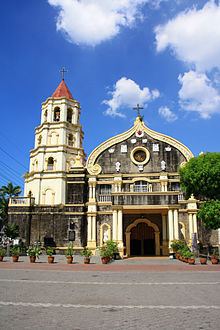Consecrated 1722 Functional status Active | Denomination Roman Catholic Cult(s) present St. James the Elder Architectural style Baroque architecture Deanery James, son of Zebedee | |
 | ||
Materials Sand, Gravel, Cement, Mortar, Brick Similar San Juan Bautista Church, San Miguel Arcangel Church, San Juan de Dios Church, Our Lady of Assumption Church, National Shrine of Saint Anne | ||
Santiago Apostol Church, also known as Plaridel Church or Quingua Church, is an 18th-century Roman Catholic Church under the patronage of Saint James the Apostle and is located along Gov. Padilla street, Brgy. Poblacion, in Plaridel, Bulacan, Philippines. In 1961, a historical marker was installed on the church by the National Historical Committee (precursor of the National Historical Commission of the Philippines).
Contents
History
The church of Plaridel, or Quingua was first established as one of the visitas of Malolos in 1581 and Fray Mateo Mendoza OSA who administered the Malolos Convent began the Christianization of Encomienda Binto y Quingua. It was located in a barrio now called "Lumangbayan" the mission chapel was soon transferred to its present location across the river Quingua (now known as Angat River) because of frequent flooding. Due to long distance of Malolos Convent to the Visita of Binto making the friars to be physically exhausted, the Augustinian prior of Malolos Fray Roque de Barrionuevo made the elevation of Visita of Binto into a Quasi-Parish in September 27, 1602. In April 30, 1605 Quingua was officially established as a full pledge Parish with Fray. Diego Pardo OSA as its first parish priest under the advocacy of Santiago de Matamoro. A Church was built on the new location starting 1602 and took 15 years to complete. The adobe stones used in the church were from the town of Meycauayan while the bricks used were made at Sitio Nabugtos at Brgy. Sta. Ines. In the year 1612, Quingua already had its own convent and 1,800 parishioners. It is said that the parish was not as wealthy as other convents in the Provincia de Bulacan during that time and that it was exempted from its fees to the Augustinian Province in the Philippines located at the San Agustin Church, Intramuros, from 1640 to 1704. The 1605 church was razed by fire after being hit by lightning. As a result, in 1722 a new church was built by Fr. Tomas Quijano on the same site. In 1772, the church was razed by fire once more but was quickly rebuilt. During the British Invasion in the 18th century, some of the treasures and documents owned by the San Agustin Monastery in Intramuros were transferred to the convent of Quingua. The church suffered immensely from an earthquake in 1863 but was repaired the same year. According to the historical marker installed by the National Historical Committee, the church also served as a military hospital and cuartel by the Americans in 1899.
Long time administered by the Archdiocese of Manila, on March 11, 1962 with the establishment of the Roman Catholic Diocese of Malolos,the Quingua Church and Convent administration and ownership was transferred to the Diocese of Malolos, making Quingua Church the center of one of the original nine vicarias of Malolos, the Vicariate of Plaridel or the Vicariate of Santiago Apostol comprising the parishes in the municipalities of Calumpit, Balagtas (Bigaa), Guiguinto and Plaridel (Quingua).
Architecture
The present stone and brick church is barn-style Baroque mixed with Moorish ornamentation. The first level of the façade consists of a main trefoil arch doorway flanked by two niches of saints. The second level, with its three windows, is plainly adorned by four pairs of pillars. The pointed arch shaped pediment (resembling a minaret), on the other hand, is richly ornamented with carvings of cherubs, saints and other embellishments surrounding the oculus or rose window. At the peak of the pediment is a carving of the pierced heart of Jesus. Attached to left of the façade is the five-storey bell tower with a quadrilateral base and octagonal upper levels and topped by a cone-shaped dome. There are five bells in the belfry, the biggest of which is dedicated to Nuestra Senora de la Consolación.
Simborio Chapel
A stone’s throw away from the church is an octagonal chapel locally known as the Simborio Chapel. Believed to be built in the 1800s, the chapel may have functioned as a mortuary chapel although its current location in a residential area is a few meters away from the current location of the Catholic cemetery. The chapel features pointed arch windows and semicircular niches on its base.
Restoration of ceiling art
Late in November 2013, efforts to restore parts of the Santiago Apostol Church, including its ceiling paintings were completed. The project’s proponent was the parish church management under the leadership of Fr. Dennis Espejo in cooperation with the AADG Restoration Group. According to project director Andrew Alto de Guzman, the task was aimed at promoting the appreciation of Quingua’s heritage. The project, which took two years to complete involved three stages. The first stage, after extensive research on the structure, was uncovering the church trusses, the tirantes or decorative beams, and the zapata or corbels which supported the original ceiling, all of which were covered in the 1970s when tin sheets and wood were used as the church ceiling. The second stage was remaking the Trompe l’oeil paintings in the ceiling based on archival photos. Among the images illustrated were those of Christ, Mary, and the twelve apostles. The artworks were done by local artists Chris Pasco, Mark Villanueva, Roy Gutierrez, Joey de Guzman and assistants. The third phase of the project centered on applying lime plaster to the upper portions of the capitals. The application of palitada was provided by Escuela Taller. The bricked up rose windows on the sides of the church were also exposed.
